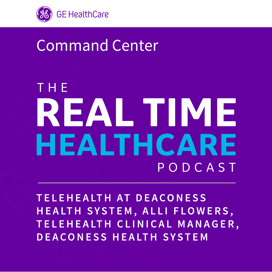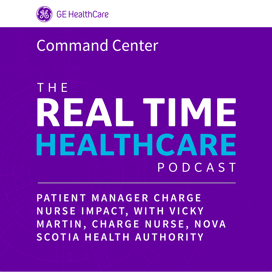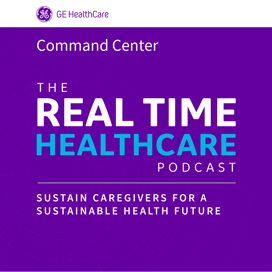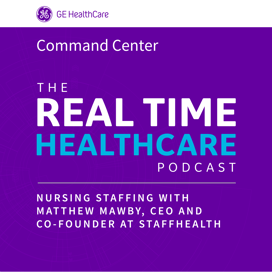Features FAQ's
No, but this is a feature in development. Integrating Command Center Tile alerts with increasingly present unified communications tools for caregiver collaboration (e.g. Spok, ASCOM, Mobile Heartbeat and Volte) will allow for automated push notifications to staff devices, and in this way will support scaling of Expediter work.
Command Center software is hosted (in client data center or GE-provided cloud), integrated with LDAP or SSO, and available with 99.9% uptime. Client’s retain control and possession of their data. 70% of current deployments are in private cloud; 30% in public cloud. Each deployment features a high availability production environment, as well as a staging environment with distinct feeds for full redundancy.
Users access Command Center software through web browsers on PCs, phones, tablets, workstations on wheels, and shared screens using their normal credentials provided the device is behind the organization’s firewall.
Command Center software is integrated via HL7, FHIR, or APIs with existing software systems like patient record, lab, radiology, pharmacy, cardiology, oncology, orders and other information systems which are usually parts of the EMR; as well as staffing and PACS systems.
Some Tiles and Modules use machine learning to forecast constraints. These algorithms re-forecast every few minutes, and then train every 24 or 48 hours.
Yes. In some cases, Command Center software integrates data from multiple distinct EMR instances or EMR vendors.
No. This feature is in development. The database work has been completed in preparation to deploy Tiles in countries like Japan or Korea which require two-byte characters.
GE HealthCare Command Center Software is used in several ways in the DOS:
- Facilitation tool for group work in rounds and huddles
- Worklist for expediting practices
- Situational awareness tool in command centers and elsewhere
- Escalation management from front-line to departments and central teams
- Communication tool for operational notes
Yes, this is a feature in development. Ability to query the Tile data models by voice. For example: “Notify me if the next hemoglobin is below 11.”
General FAQ's
GE HealthCare Command Center technology uses artificial intelligence in Real Time to support the optimal delivery of patient care, hubs to monitor performance and learn and launch improvement programs and focal points to drive a transparent, integrated culture.
Command Center software is a real-time and predictive control system for ongoing patient care orchestration. Staff use it to collaborate in rounds and huddles; to see, get ahead of- and track risks; to communicate between teams, and to prioritize.
Real Time Healthcare is a healthcare system in which stakeholders share, adopt and apply medical knowledge in real time. Real Time Healthcare enables improved care, accelerated workflows, streamlined business processes and a better balance of resources with demand.
In this context, “real time” indicates that information in Command Center Tiles is updating every 30 seconds for users. These updates are based on changes in the data model which have occurred since the prior update to the user (30 seconds ago).
Leading providers with these legacy smaller centres are already replacing them with command centres. These new centres are multi-purpose and scalable. They manage patients into, through and out of the hospital. They manage patient safety and experience, not just bed management or transfers. They include care management and strategy not just housekeeping and transport. They also incorporate predictive and prescriptive decision support tools, not just dashboards from IT systems.
Command Center software fills gaps where EMRs struggle. These gaps tend to be where multi-modal information is required, where the information regularly changes on a minute-to-minute basis, where a predictive algorithm is needed to make a decision now, where protocol logic is complex, and where staff must rapidly collaborate across disciplines. EMR architecture makes all of these difficult.
GE HealthCare’s Command Center software is agnostic to EMR/EPR/PAS topology. Data is ingested from whichever sub-systems as needed (based on Tile and Module selection) and harmonized within the CC software platform. Current deployments include as many as 14 distinct EMR instances feeding a single CC instance, which provides Tiles to users with seamless enterprise-wide information.
The term “Electronic Medical Record” (EMR) is used in North America to mean a collection of software sub-systems including the patient record, order entry system, lab information system, radiology information system, cardiology information system and so forth. In the 1990s and 2000s, there were competing vendors for each sub-system. Leading vendors today provide an integrated solution which includes many or most of these sub-systems, with the largest providing 20 or more modules. EMRs were once typically hosted in health system data centers, but are increasingly hosted in either health system-managed 3rd-party cloud or EMR vendor-provided cloud.
The term “Electronic Patient Record” (EPR) is used worldwide to refer to a software system which digitizes the patient chart or record. It is usually accompanied by a Patient Administration System or PAS. EPRs and PASs are sometimes referenced synonymously with EMRs, but this risks confusion on the actual scope of software being provided.
Command Center software is used in over 300 hospitals in the US, Canada, UK and The Netherlands including The Johns Hopkins Hospital, Humber River Hospital, OHSU Health, Tampa General Hospital, Duke, Providence, Virginia Mason Franciscan Health, AdventHealth, HCA North Carolina, HCA Palm Beach and Thomas Jefferson Health.
Integration time varies with each healthcare situation. We would love to speak with you about the needs of your organization. Please contact us to setup a demo and discussion.
We would love to speak with you about the needs of your organization. Please contact us to setup a demo and discussion.
By creating a Digital Twin of your hospital(s) (and related ambulatory services), we can test potential changes in operational strategy, capacities, staffing, and care delivery models to objectively determine which actions to take.
Digital Twins target process improvement efforts by putting each process improvement project into larger context. This enables us to charter projects with specific goals tied to both local and system performance.
Click here to explore Digital Twin impact
Outcomes FAQ's
Command Center programs have a meaningful impact on organizational culture. The design-thinking approach brings together groups of multi-disciplinary stakeholders to innovate, solve problems, and find ways of better working together. The Command Center itself forms a centre of gravity for operations and continuous improvement, and it becomes a source of pride for the organization.
Command Centre Tiles align stakeholders across the enterprise to a single version of the Truth. They break down barriers between departments and eliminate the siloed working that often causes inefficiency and sub-optimal decision-making.
By enabling a more efficient operation, Command Centre programs tend to free staff of much of the wasted time and rework they experience throughout the day. This has allowed staff to spend more time on the value-added parts of their role.
Organizations invest in Real Time Healthcare capabilities to improve quality and efficiency. This includes positive ROI and a reasonable pay-back period. Johns Hopkins, Humber River, OHSU, Tampa General, and Virginia Mason Franciscan have publicly released results from this work. Each has reached break-even in 12 – 18 months on the way to a 4:1 or greater ROI by year 5.
With better information at their fingertips and better visibility to demand, pressure and risk, hospitals with Command Centre can deliver a more predictable and consistent experience to their patients with less time spent waiting unnecessarily or receiving care in a suboptimal setting.
Tiles FAQ's
Tiles are Real Time healthcare "apps" within Command Center software. They optimize and put hospital data to work.

Patient Manager Tile is a personalized Command Center for every caregiver. It digitizes the patient journey for all patients so care-teams and departments can create their own curated lenses on the action in order to, for example, identify the most important discharges to break current patient flow bottlenecks, orchestrate efficient care progression, reduce excess days, and anticipate and resolve risks to protocol compliance.
Because the Tile updates constantly, the entire care team can see the same critical information, at the same time… which shifts conversations from collecting information to problem solving. Each user sets and saves profiles based on their interest.
Enables staff to quickly understand the current and near-term balance of staffed bed capacity. Users easily navigate through unit, level of care, service, hospital, division, region, etc. to understand the bed balance from census to targeted admits, pending discharges, transfers and room cleaning in process, blocked beds and patients at a mismatched level of care.
Discharge Planning Tile facilitates effective discharge planning and coordination of post-acute needs by putting all relevant information in one place such as dates (admit, GMLOS, anticipated discharge, discharge order), possible dispositions, and pending orders.
This enables high-speed coordination during rounding and ad-hoc discussions. The Tile’s “smarts” focus attention on critical path tasks essential for on-time post-acute placement.
Observation Management Tile creates what some users call a “virtual observation unit” by adding key information including mismatches between provider and care management classification, risk of breaching 48-hour or two-midnight rule based on payor and pending tasks, and other indicators of misclassification.
The Unit or Ward Link Tile organizes information from all Tiles into a view optimized for each nursing unit or service. Information from all live Tiles is pulled into a single row for each bed or patient.
Expediter Tiles give real time situational awareness and enable immediate action to expedite patient-specific activity such as delayed labs, imaging or consults.
There are several Expediter Tiles:
- Capacity Expediter. Enables staff to quickly understand the current and near-term balance of staffed bed capacity. Users easily navigate through unit, level of care, service, hospital, division, region, etc. to understand the bed balance from census to targeted admits, pending discharges, transfers and room cleaning in process, blocked beds and patients at a mismatched level of care.
- ED Expediter. Provides real time situational awareness of recent ED arrival patterns, current pressure and break-down of patients waiting for labs, imaging, consults and beds; and it provides patient-level alerts for delays as well as frequent flyers, readmission risk, missing paperwork, etc.
- Transfers Expediter. Provides real time awareness of patients waiting to enter and exit the health system or move between facilities. Moreover, it helps the team to drive the next step from physician-to-physician discussions through admission, bed assignment and arrival. The Tile also highlights opportunities to reroute patients based on current capacity constraints.
- Imaging Expediter. Provides current and predicted utilization of selected imaging modalities, prioritizes the queue of inpatient scans according to each hospital’s desired configuration, pinpoints patient-readiness issues which will disrupt smooth flow, and highlights when the read of completed scans is delayed.
- Boarders Expediter. Helps to expedite movement of delayed patients who are boarding in places like ED, OR, PACU and Direct Admissions. The Tile spotlights these patients, suggests matching beds when one is available but not assigned, alerts when an assigned bed is clean but transport hasn’t been called, and highlights rare issues like patients with both an admit and discharge order.
Imaging Growth Tile helps to optimize imaging volume and flow by providing scheduled and forecasted volume for the next two weeks, including predicted no-shows, along with anticipated open slots to highlight future days which are not filling as expected (all built from patient-level data, not statistics).
Moreover, the Tile pinpoints readiness issues (like missing or contraindicated labs, and wrong IV location) which may disrupt patient flow.
Surgical or Procedural Growth Tile helps to optimize surgical volume and flow by providing scheduled and forecasted case load for the next two weeks along with anticipated open time and downstream bed requirements (all built from patient-level data, not statistics).
Moreover, the Tile pinpoints readiness issues (like missing or contraindicated labs) which may disrupt patient flow on the day of surgery or procedure.
Census and Staffing Forecast Tile suggests opportunities to rebalance staffing over the next 7-10 days by comparing predicted unit-level census (derived with machine learning) with scheduled staffing and predicted call-outs. Easy to organize for a certain level-of-care or service-line across facilities.
Tiles update every 30 seconds. (They change while you’re looking at them, like airport signage boards)
National Capacity System Tile is proven state-wide in Oregon and Florida; and province-wide in Saskatchewan.
Features
- Extends across all health resources, etc. Current deployments include acute hospitals, psych hospitals, rehab hospitals, LTACs and SNFs.
scales across counties, regions, provinces, countries, etc. No PHI is ingested. - Scales to different information types. Current deployments include ICU beds, acute beds, specialty beds, vents, surge beds, COVID infection numbers, PPE data, with more being added.
- Rapidly deployed and affordable. Total deployment takes ~30 days.
- Each facility’s effort to send data takes less than 1 hour – we make it easy for them.
- Supports emergency management with near-time reliable information instead of phone calls and aged excel sheets. This is essential when a region is overwhelmed by COVID, or hospitals need to be evacuated due to fire, flood or hurricane; mass casualty; earthquake, etc.
- No patient identifiable information is collected.
Resources







